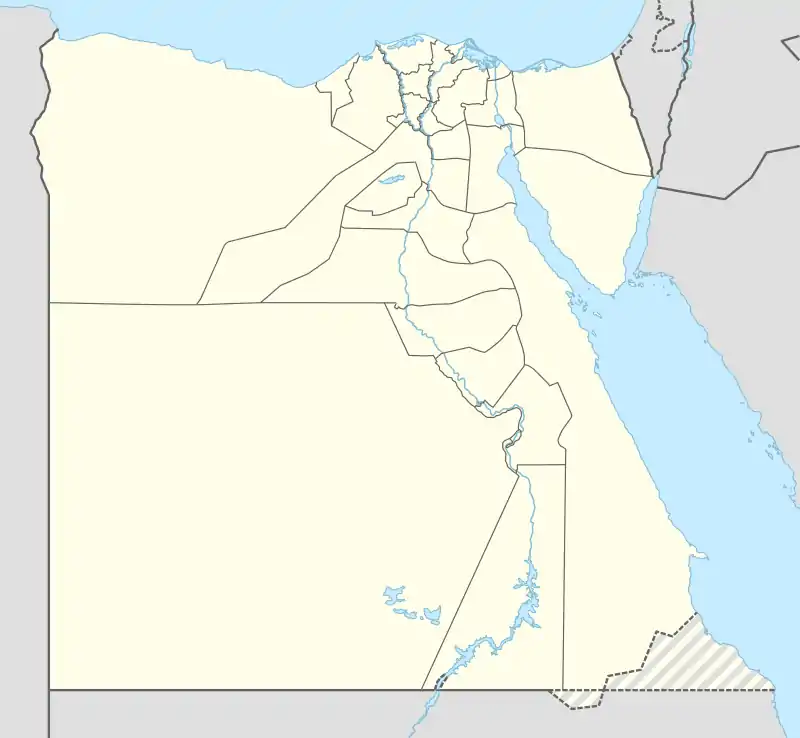Upper Egypt
Upper Egypt (Arabic: صعيد مصر Ṣaʿīd Miṣr, shortened to الصعيد, Egyptian Arabic pronunciation: [es.sˤe.ˈʕiːd], locally: [es.sˤɑ.ˈʕiːd]; Coptic: ⲙⲁⲣⲏⲥ, romanized: Mares) is the southern portion of Egypt and is composed of the Nile River valley south of the delta and the 30th parallel N. It thus consists of the entire Nile River valley from Cairo south to Lake Nasser (formed by the Aswan High Dam).[2]
Upper Egypt | |||||||||
|---|---|---|---|---|---|---|---|---|---|
| c. 3400 BC – c. 3150 BC | |||||||||
Map of Upper Egypt showing important sites that were occupied during Naqada III (clickable map) | |||||||||
| Capital | Thinis | ||||||||
| Common languages | Ancient Egyptian | ||||||||
| Religion | Ancient Egyptian religion | ||||||||
| Government | Monarchy | ||||||||
| King | |||||||||
• c. 3400 BC | Scorpion I (first) | ||||||||
• c. 3150 BC | Narmer (last) | ||||||||
| History | |||||||||
• Established | c. 3400 BC | ||||||||
• Disestablished | c. 3150 BC | ||||||||
| |||||||||
| Today part of | Egypt | ||||||||
| History of Egypt |
|---|
 |
|
|
| Periods and dynasties of ancient Egypt |
|---|
|
All years are BC |
|
See also: List of pharaohs by period and dynasty Periodization of ancient Egypt |
In ancient Egypt, Upper Egypt was known as tꜣ šmꜣw,[3] literally "the Land of Reeds" or "the Sedgeland", named for the sedges that grow there.[4] It is believed to have been united by the rulers of the supposed Thinite Confederacy who absorbed their rival city states during the Naqada III period (c. 3200–3000 BC), and its subsequent unification with Lower Egypt ushered in the Early Dynastic period.[5] Upper and Lower Egypt became intertwined in the symbolism of pharaonic sovereignty such as the Pschent double crown.[6] Upper Egypt remained as a historical region even after the classical period.
Geography
Upper Egypt is between the Cataracts of the Nile beyond modern-day Aswan, downriver (northward) to the area of El-Ayait,[7] which places modern-day Cairo in Lower Egypt. The northern (downriver) part of Upper Egypt, between Sohag and El-Ayait, is also known as Middle Egypt.
In Arabic, inhabitants of Upper Egypt are known as Sa'idis and they generally speak Sai'idi Egyptian Arabic.

History

Predynastic Egypt
The main city of prehistoric Upper Egypt was Nekhen.[8] The patron deity was the goddess Nekhbet, depicted as a vulture.[9]
By approximately 3600 BC, Neolithic Egyptian societies along the Nile based their culture on the raising of crops and the domestication of animals.[10] Shortly thereafter, Egypt began to grow and increase in complexity.[11] A new and distinctive pottery appeared, related to the Levantine ceramics, and copper implements and ornaments became common.[11] Mesopotamian building techniques became popular, using sun-dried adobe bricks in arches and decorative recessed walls.[11]
In Upper Egypt, the predynastic Badari culture was followed by the Naqada culture (Amratian),[12] closely related to the Lower Nubian;[13][14][15][16] other northeast African populations[17] and some tropical African groups.[18][19] Also, the proto-dynastic kings emerged from the Naqada region.[20] Excavations at Hierakonpolis (Upper Egypt) found archaeological evidence of ritual masks similar to those used further south of Egypt, and obsidian linked to Ethiopian quarry sites.[21]
Frank Yurco stated that depictions of pharonic iconography such as the royal crowns, Horus falcons and victory scenes were concentrated in the Upper Egyptian Naqada culture and A-Group Lower Nubia. He further elaborated that "Egyptian writing arose in Naqadan Upper Egypt and A-Group Lower Nubia, and not in the Delta cultures, where the direct Western Asian contact was made, further vititates the Mesopotamian-influence argument".[22]
Similarly, Christopher Ehret, historian and linguist, stated that the cultural practice of sacral chiefship and kingship which emerged in Upper Egypt in the fourth millennium had originated centuries earlier in Nubia and the Middle Nile south of Egypt. He based this judgement on supporting, archaeological and comparative ethnographic evidence.[23]
According to bioarchaeologist Nancy Lovell, the morphology of ancient Egyptian skeletons gives strong evidence that "In general, the inhabitants of Upper Egypt and Nubia had the greatest biological affinity to people of the Sahara and more southerly areas" but exhibited local variation in an African context.[24]
S. O. Y. Keita, a biological anthropologist also reviewed studies on the biological affinities of the Ancient Egyptian population and characterised the skeletal morphologies of predynastic southern Egyptians as a "Saharo-tropical African variant". Keita had also added that whilst Egyptian society became more socially complex and biologically varied, the "ethnicity of the Niloto-Saharo-Sudanese origins did not change".[25]
These cultural advances paralleled the political unification of towns of the upper Nile River, or Upper Egypt, while the same occurred in the societies of the Nile Delta, or Lower Egypt.[11] This led to warfare between the two new kingdoms.[11] During his reign in Upper Egypt, King Narmer defeated his enemies on the delta and became sole ruler of the two lands of Upper and Lower Egypt,[26] a sovereignty which endured throughout Dynastic Egypt.
Dynastic Egypt
In royal symbolism, Upper Egypt was represented by the tall White Crown Hedjet, the flowering lotus, and the sedge. Its patron deity, Nekhbet, was depicted by the vulture. After unification, the patron deities of Upper and Lower Egypt were represented together as the Two Ladies, to protect all of the ancient Egyptians, just as the two crowns were combined into a single pharaonic diadem.
Several dynasties of southern or Upper Egyptian origin, which included the 11th, 12th, 17th, 18th and 25th dynasties, reunified and reinvigorated pharaonic Egypt after periods of fragmentation.[27]
For most of Egypt's ancient history, Thebes was the administrative center of Upper Egypt. After its devastation by the Assyrians, the importance of Egypt declined. Under the dynasty of the Ptolemies, Ptolemais Hermiou took over the role of the capital city of Upper Egypt.[28]
A 2005 study on Theban nobles had found that the mummified remains had a histology which "indicated notably dark skin".[29]
Medieval Egypt
In the eleventh century, large numbers of pastoralists, known as Hilalians, fled Upper Egypt and moved westward into Libya and as far as Tunis.[30] It is believed that degraded grazing conditions in Upper Egypt, associated with the beginning of the Medieval Warm Period, were the root cause of the migration.[31]
20th-century Egypt
In the twentieth-century Egypt, the title Prince of the Sa'id (meaning Prince of Upper Egypt) was used by the heir apparent to the Egyptian throne.[Note 1]
Although the Kingdom of Egypt was abolished after the Egyptian revolution of 1952, the title continues to be used by Muhammad Ali, Prince of the Sa'id.
List of rulers of prehistoric Upper Egypt
The following list may not be complete (there are many more of uncertain existence):
| Name | Image | Comments | Dates |
|---|---|---|---|
| Elephant | End of 4th millennium BC | ||
| Bull | 4th millennium BC | ||
| Scorpion I | Oldest tomb at Umm el-Qa'ab had scorpion insignia | c. 3200 BC? | |
| Iry-Hor |  |
Possibly the immediate predecessor of Ka. | c. 3150 BC? |
| Ka[33][34] |  |
May be read Sekhen rather than Ka. Possibly the immediate predecessor of Narmer. | c. 3100 BC |
| Scorpion II |  |
Potentially read Serqet; possibly the same person as Narmer. | c. 3150 BC |
| Narmer |  |
The king who combined Upper and Lower Egypt.[35] | c. 3150 BC |
List of nomes
| Number | Ancient Name | Capital | Modern Capital | Translation | God |
|---|---|---|---|---|---|
| 1 | Ta-khentit | Abu / Yebu (Elephantine) | Aswan | The Frontier/Land of the Bow | Khnemu |
| 2 | Wetjes-Hor | Djeba (Apollonopolis Magna) | Edfu | Throne of Horus | Horus-Behdety |
| 3 | Nekhen | Nekhen (Hierakonpolis) | al-Kab | Shrine | Nekhebet |
| 4 | Waset | Niwt-rst / Waset (Thebes) | Karnak | Sceptre | Amun-Ra |
| 5 | Harawî | Gebtu (Coptos) | Qift | Two Falcons | Min |
| 6 | Aa-ta | Iunet / Tantere (Tentyra) | Dendera | Crocodile | Hathor |
| 7 | Seshesh | Seshesh (Diospolis Parva) | Hu | Sistrum | Hathor |
| 8 | Ta-wer | Tjenu / Abjdu (Thinis / Abydos) | al-Birba | Great Land | Onuris |
| 9 | Min | Apu / Khen-min (Panopolis) | Akhmim | Min | Min |
| 10 | Wadjet | Djew-qa / Tjebu (Antaeopolis) | Qaw al-Kebir | Cobra | Hathor |
| 11 | Set | Shashotep (Hypselis) | Shutb | Set animal | Khnemu |
| 12 | Tu-ph | Per-Nemty (Hieracon) | At-Atawla | Viper Mountain | Horus |
| 13 | Atef-Khent | Zawty (Lycopolis) | Asyut | Upper Sycamore and Viper | Apuat |
| 14 | Atef-Pehu | Qesy (Cusae) | al-Qusiya | Lower Sycamore and Viper | Hathor |
| 15 | Wenet | Khemenu (Hermopolis) | Hermopolis | Hare[36] | Thoth |
| 16 | Ma-hedj | Herwer? | Hur? | Oryx[36] | Horus |
| 17 | Anpu | Saka (Cynopolis) | al-Kais | Anubis | Anubis |
| 18 | Sep | Teudjoi / Hutnesut (Alabastronopolis) | el-Hiba | Set | Anubis |
| 19 | Uab | Per-Medjed (Oxyrhynchus) | el-Bahnasa | Two Sceptres | Set |
| 20 | Atef-Khent | Henen-nesut (Heracleopolis Magna) | Ihnasiyyah al-Madinah | Southern Sycamore | Heryshaf |
| 21 | Atef-Pehu | Shenakhen / Semenuhor (Crocodilopolis, Arsinoë) | Faiyum | Northern Sycamore | Khnemu |
| 22 | Maten | Tepihu (Aphroditopolis) | Atfih | Knife | Hathor |
Governorates and large cities
Nowadays, Upper Egypt forms part of these 7 governorates:
Large cities located in Upper Egypt:
Explanatory notes
- The title was first used by Prince Farouk, the son and heir of King Fouad I. Prince Farouk was officially named Prince of the Sa'id on 12 December 1933.[32]
References
Citations
- Ermann & Grapow, op.cit. Wb 5, 227.4-14
- "Upper Egypt". Encyclopædia Britannica. Retrieved 5 January 2023.
- Ermann & Grapow 1982, Wb 5, 227.4-14.
- Ermann & Grapow (1982), Wb 4, 477.9-11
- Brink, Edwin C. M. van den (1992). "The Nile Delta in Transition: 4th.-3rd. Millennium B.C." Proceedings of the Seminar Held in Cairo, 21.-24. October 1990, at the Netherlands Institute of Archaeology and Arabic Studies. E.C.M. van den Brink. ISBN 978-965-221-015-9.
- Griffith, Francis Llewellyn, A Collection of Hieroglyphs: A Contribution to the History of Egyptian Writing, the Egypt Exploration Fund 1898, p. 56
- See list of nomes. Maten (Knife land) is the northernmost nome in Upper Egypt on the right bank, while Atef-Pehu (Northern Sycamore land) is the northernmost on the left bank. Brugsch, Heinrich Karl (2015). A History of Egypt under the Pharaohs. Vol. 1. Cambridge, England: Cambridge University Press. p. 487., originally published in 1876 in German.
- Bard & Shubert (1999), p. 371
- David (1975), p. 149
- Roebuck (1966), p. 51
- Roebuck (1966), pp. 52–53
- Brace, 1993. Clines and clusters
- Zakrzewski, Sonia R. (April 2007). "Population continuity or population change: Formation of the ancient Egyptian state". American Journal of Physical Anthropology. 132 (4): 501–509. doi:10.1002/ajpa.20569. PMID 17295300.
When Mahalanobis D2 was used, the Naqadan and Badarian Predynastic samples exhibited more similarity to Nubian, Tigrean, and some more southern series than to some mid- to late Dynasticseries from northern Egypt (Mukherjee et al., 1955). The Badarian have been found to be very similar to a Kerma sample (Kushite Sudanese), using both the Penrose statistic (Nutter, 1958) and DFA of males alone (Keita,1990). Furthermore, Keita considered that Badarian males had a southern modal phenotype, and that together with a Naqada sample, they formed a southern Egyptian cluster as tropical variants together with a sample from Kerma
- Tracy L. Prowse, Nancy C. Lovell. "Concordance of cranial and dental morphological traits and evidence for endogamy in ancient Egypt", American Journal of Physical Anthropology, Vol. 101, Issue 2, October 1996, pp. 237-246
- Godde, Kane. "A biological perspective of the relationship between Egypt, Nubia, and the Near East during the Predynastic period (2020)". Retrieved 16 March 2022.
- Mokhtar, Gamal, ed. (1981). Ancient Civilizations of Africa. UNESCO International Scientific Committee for the Drafting of a General History of Africa; Heinemann Educational Books; University of California Press. pp. 20–21, 148. ISBN 978-0-520-03913-1.
The difference in behaviour between two populations of similar ethnic composition throws significant light on an apparently abnormal fact: one of them adopted and perhaps even invented, a system of writing, while the other, which was aware of that writing, disdained it
- Ehret, Christopher (20 June 2023). Ancient Africa: A Global History, to 300 CE. Princeton: Princeton University Press. pp. 84–85. ISBN 978-0-691-24409-9.
- Keita, S. O. Y. (November 2005). "Early Nile Valley Farmers From El-Badari: Aboriginals or 'European' AgroNostratic Immigrants? Craniometric Affinities Considered with Other Data". Journal of Black Studies. 36 (2): 191–208. doi:10.1177/0021934704265912. ISSN 0021-9347. S2CID 144482802.
- Keita, S. O. Y. (September 1990). "Studies of ancient crania from northern Africa". American Journal of Physical Anthropology. 83 (1): 35–48. doi:10.1002/ajpa.1330830105. ISSN 0002-9483. PMID 2221029.
- The Cambridge history of Africa. Cambridge: Cambridge University Press. 1975–1986. pp. 500–509. ISBN 9780521222150.
- Davies, W. V. (1998). Egypt uncovered. New York: Stewart, Tabori & Chang. pp. 5–87. ISBN 1556708181.
- Yurco, Frank J. (1996). "The Origin and Development of Ancient Nile Valley Writing". In Theodore Celenko (ed.). Egypt in Africa. Indianapolis: Indianapolis Museum of Art. pp. 34–35. ISBN 0-936260-64-5.
- Ehret, Christopher (20 June 2023). Ancient Africa: A Global History, to 300 CE. Princeton University Press. p. 141. ISBN 978-0-691-24410-5.
- Lovell, Nancy C. (1999). "Egyptians, physical anthropology of". In Bard, Kathryn A.; Shubert, Steven Blake (eds.). Encyclopedia of the Archaeology of Ancient Egypt. London: Routledge. pp. 328–331. ISBN 0415185890.
There is now a sufficient body of evidence from modern studies of skeletal remains to indicate that the ancient Egyptians, especially southern Egyptians, exhibited physical characteristics that are within the range of variation for ancient and modern indigenous peoples of the Sahara and tropical Africa. The distribution of population characteristics seems to follow a clinal pattern from south to north, which may be explained by natural selection as well as gene flow between neighboring populations. In general, the inhabitants of Upper Egypt and Nubia had the greatest biological affinity to people of the Sahara and more southerly areas
- Keita, S. O. Y. (1993). "Studies and Comments on Ancient Egyptian Biological Relationships". History in Africa. 20: 129–154. doi:10.2307/3171969. ISSN 0361-5413. JSTOR 3171969. S2CID 162330365.
- Roebuck (1966), p. 53
- "It is important to note that historically not only was Upper Egypt the source of the core identifiable Egyptian culture, but that it was primarily southerners of the Eleventh/Twelfth, Seventeenth/Eighteenth, and Twenty-fifth Dynasties who politically reunited Egypt and reinvigorated its culture"Keita, S. O. Y. (September 2022). "Ideas about "Race" in Nile Valley Histories: A Consideration of "Racial" Paradigms in Recent Presentations on Nile Valley Africa, from "Black Pharaohs" to Mummy Genomest". Journal of Ancient Egyptian Interconnections.
- Chauveau (2000), p. 68
- Keita Shomarka. (2022). "Ancient Egyptian "Origins and "Identity" In Ancient Egyptian society : challenging assumptions, exploring approaches. Abingdon, Oxon. pp. 111–122. ISBN 978-0367434632.
{{cite book}}: CS1 maint: location missing publisher (link) - Ballais (2000), p. 133
- Ballais (2000), p. 134
- Brice (1981), p. 299
- Rice 1999, p. 86.
- Wilkinson 1999, p. 57f.
- Shaw 2000, p. 196.
- Grajetzki (2006), pp. 109–111
General and cited references
- Ballais, Jean-Louis (2000). "Conquests and land degradation in the eastern Maghreb". In Graeme Barker; David Gilbertson (eds.). Sahara and Sahel. The Archaeology of Drylands: Living at the Margin. Vol. 1, Part III. London: Routledge. pp. 125–136. ISBN 978-0-415-23001-8.
- Bard, Katheryn A.; Shubert, Steven Blake (1999). Encyclopedia of the Archaeology of Ancient Egypt. London: Routledge. ISBN 0-415-18589-0.
- Brice, William Charles (1981). An Historical Atlas of Islam. Leiden: Brill. ISBN 90-04-06116-9. OCLC 9194288.
- Chauveau, Michel (2000). Egypt in the Age of Cleopatra: History and Society Under the Ptolemies. Ithaca, NY: Cornell University Press. ISBN 0-8014-3597-8.
- David, Ann Rosalie (1975). The Egyptian Kingdoms. London: Elsevier Phaidon. OCLC 2122106.
- Ermann, Johann Peter Adolf; Grapow, Hermann (1982). Wörterbuch der Ägyptischen Sprache [Dictionary of the Egyptian Language] (in German). Berlin: Akademie. ISBN 3-05-002263-9.
- Grajetzki, Wolfram (2006). The Middle Kingdom of ancient Egypt: History, Archaeology and Society. London: Duckworth Egyptology. ISBN 978-0-7156-3435-6.
- Rice, Michael (1999). Who's Who in Ancient Egypt. London: Routledge. ISBN 978-0-415-15449-9.
- Roebuck, Carl (1966). The World of Ancient Times. New York, NY: Charles Scribner's Sons Publishing.
- Shaw, Ian (2000). The Oxford History of Ancient Egypt. Oxford, UK: Oxford University Press. ISBN 978-0-19-280458-7.
- Wilkinson, Toby A. H. (1999). Early Dynastic Egypt. London: Routledge. ISBN 0-415-18633-1.
Further reading
External links
- References to Upper Egypt in Coptic Literature—Coptic Scriptorium database
